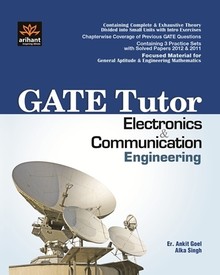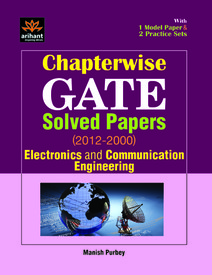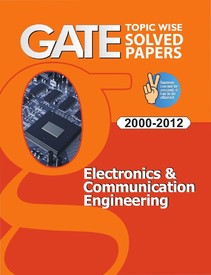|
#1
July 11th, 2014, 09:35 AM
| |||
| |||
| GATE ECE reference books and the syllabus
I want to give the exam of GATE and for that I want to get the list of some of the best GATE ECE reference books and the syllabus so can you please make it available for me? As you want to get the list of some of the best GATE ECE reference books and the syllabus so here it is for you: Reference books: S.No. Book Title Author 1. Network Analysis Van Valkenburg 2. Engineering Circuit Analysis Hayt, Kemmerly and Durbin 3. Problems and Solutions in Network Analysis GK Publications 4. Network Theory Prof. Yoganarasimham 5. Circuit Theory A Chakravarthy 6. Networks & Systems Roy Choudary 7. Network Analysis Soni and Gupta 8. Transmission Lines and Networks Umesh Sinha 9. Electric Circuits Edministe and Nahvi, Schaum’s Series 10. EDC Theory Boylested and Nashelsky 11. Micro Electronic Circuits Sedra and Smith 12. Micro Electronics Millman and Grabel 13. Electronic Devices and Circuits Millman, Halkias 14. Electronic Circuits Schilling, Belove 15. Electronic Principles Malvino, Leach 16. Linear Integrated Circuits Roy Choudary 17. OP Amps and Linear Integrated Circuits Gayakwad 18. Applications of Analog Integrated Circuits Sidney Soclof 19. Switching and Finite Automatic Theory Kohavi 20. Digital Logic and Computer Design Morris Mano 21. Digital Integrated Electronics Taub and Schilling 22. Modern Digital Electronics RP Jain 23. Pulse and Digital Electronics Millman and Taub 24. Digital Systems, Principles & Applications Tocci and Pearson 25. Digital Electronics Malvino and Leach 26. Microprocessor and its Applications Goankar S Ramesh 27. Microprocessor B Ram 28. Microprocessor Doughlus V Hall 29. Control Systems Nagarath and Gopal 30. Automatic Control Systems BC Kuo 31. Modern Control Engineering Ogata 32. Signal Systems and Communication BP lathi 33. Signals and Systems Simon Haykin and Bang Vanveen 34. Signals and Systems Oppenhiem, Wilsky and Nawab 35. Communication Systems Simon Haykins 36. Communication Systems Bruce Carlson 37. Electronic Communication Systems Kennedy and Davis 38. Digital and Analog Communication Systems K Sam Shanmugam 39. Principles of Communication Systems Taub and Schilling 40. Communications BP Lathi 41. Engineering Electromagnetics William Hayt 42. Electro Magnetic waves and Radiating Systems Jordon and ballmain 43. Problems and Solutions of Engineering Electromagnetics By Experienced Teachers 44. Field Theory KA Gangadhar 45. Elements of Electromagnetics NO Sadiku 46. GATE previous question papers only GK Publications 47. Previous IES (Objective questions only) Question Papers GK Publications    Syllabus: Linear Algebra: Matrix Algebra, Systems of linear equations, Eigen values and eigen vectors. Calculus: Mean value theorems, Theorems of integral calculus, Evaluation of definite and improper integrals, Partial Derivatives, Maxima and minima, Multiple integrals, Fourier series. Vector identities, Directional derivatives, Line, Surface and Volume integrals, Stokes, Gauss and Green's theorems. Differential equations: First order equation (linear and nonlinear), Higher order linear differential equations with constant coefficients, Method of variation of parameters, Cauchy's and Euler's equations, Initial and boundary value problems, Partial Differential Equations and variable separable method. Complex variables: Analytic functions, Cauchy's integral theorem and integral formula, Taylor's and Laurent' series, Residue theorem, solution integrals. Probability and Statistics: Sampling theorems, Conditional probability, Mean, median, mode and standard deviation, Random variables, Discrete and continuous distributions, Poisson, Normal and Binomial distribution, Correlation and regression analysis. Numerical Methods: Solutions of non-linear algebraic equations, single and multi-step methods for differential equations. Transform Theory: Fourier transform, Laplace transform, Z-transform. Electronics and Communication Engineering Networks: Network graphs: matrices associated with graphs; incidence, fundamental cut set and fundamental circuit matrices. Solution methods: nodal and mesh analysis. Network theorems: superposition, Thevenin and Norton's maximum power transfer, Wye-Delta transformation. Steady state sinusoidal analysis using phasors. Linear constant coefficient differential equations; time domain analysis of simple RLC circuits, Solution of network equations using Laplace transform: frequency domain analysis of RLC circuits. 2-port network parameters: driving point and transfer functions. State equations for networks. Electronic Devices: Energy bands in silicon, intrinsic and extrinsic silicon. Carrier transport in silicon: diffusion current, drift current, mobility, and resistivity. Generation and recombination of carriers. p-n junction diode, Zener diode, tunnel diode, BJT, JFET, MOS capacitor, MOSFET, LED, p-I-n and avalanche photo diode, Basics of LASERs. Device technology: integrated circuits fabrication process, oxidation, diffusion, ion implantation, photolithography, n-tub, p-tub and twin-tub CMOS process. Analog Circuits: Small Signal Equivalent circuits of diodes, BJTs, MOSFETs and analog CMOS. Simple diode circuits, clipping, clamping, rectifier. Biasing and bias stability of transistor and FET amplifiers. Amplifiers: single-and multi-stage, differential and operational, feedback, and power. Frequency response of amplifiers. Simple op-amp circuits. Filters. Sinusoidal oscillators; criterion for oscillation; single-transistor and op-amp configurations. Function generators and wave-shaping circuits, 555 Timers. Power supplies. Digital circuits: Boolean algebra, minimization of Boolean functions; logic gates; digital IC families (DTL, TTL, ECL, MOS, CMOS). Combinatorial circuits: arithmetic circuits, code converters, multiplexers, decoders, PROMs and PLAs. Sequential circuits: latches and flip-flops, counters and shift-registers. Sample and hold circuits, ADCs, DACs. Semiconductor memories. Microprocessor(8085): architecture, programming, memory and I/O interfacing. Signals and Systems: Definitions and properties of Laplace transform, continuous-time and discrete-time Fourier series, continuous-time and discrete-time Fourier Transform, DFT and FFT, z-transform. Sampling theorem. Linear Time-Invariant (LTI) Systems: definitions and properties; causality, stability, impulse response, convolution, poles and zeros, parallel and cascade structure, frequency response, group delay, phase delay. Signal transmission through LTI systems. Control Systems: Basic control system components; block diagrammatic description, reduction of block diagrams. Open loop and closed loop (feedback) systems and stability analysis of these systems. Signal flow graphs and their use in determining transfer functions of systems; transient and steady state analysis of LTI control systems and frequency response. Tools and techniques for LTI control system analysis: root loci, Routh-Hurwitz criterion, Bode and Nyquist plots. Control system compensators: elements of lead and lag compensation, elements of Proportional-Integral-Derivative (PID) control. State variable representation and solution of state equation of LTI control systems. Communications: Random signals and noise: probability, random variables, probability density function, autocorrelation, power spectral density. Analog communication systems: amplitude and angle modulation and demodulation systems, spectral analysis of these operations, superheterodyne receivers; elements of hardware, realizations of analog communication systems; signal-to-noise ratio (SNR) calculations for amplitude modulation (AM) and frequency modulation (FM) for low noise conditions. Fundamentals of information theory and channel capacity theorem. Digital communication systems: pulse code modulation (PCM), differential pulse code modulation (DPCM), digital modulation schemes: amplitude, phase and frequency shift keying schemes (ASK, PSK, FSK), matched filter receivers, bandwidth consideration and probability of error calculations for these schemes. Basics of TDMA, FDMA and CDMA and GSM. Electromagnetics: Elements of vector calculus: divergence and curl; Gauss' and Stokes' theorems, Maxwell's equations: differential and integral forms. Wave equation, Poynting vector. Plane waves: propagation through various media; reflection and refraction; phase and group velocity; skin depth. Transmission lines: characteristic impedance; impedance transformation; Smith chart; impedance matching; S parameters, pulse excitation. Waveguides: modes in rectangular waveguides; boundary conditions; cut-off frequencies; dispersion relations. Basics of propagation in dielectric waveguide and optical fibers. Basics of Antennas: Dipole antennas; radiation pattern; antenna gain. Last edited by Neelurk; June 10th, 2020 at 11:50 AM. |